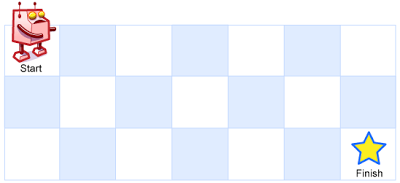英文原文
A robot is located at the top-left corner of a m x n grid (marked 'Start' in the diagram below).
The robot can only move either down or right at any point in time. The robot is trying to reach the bottom-right corner of the grid (marked 'Finish' in the diagram below).
How many possible unique paths are there?
Example 1:

Input: m = 3, n = 7 Output: 28
Example 2:
Input: m = 3, n = 2 Output: 3 Explanation: From the top-left corner, there are a total of 3 ways to reach the bottom-right corner: 1. Right -> Down -> Down 2. Down -> Down -> Right 3. Down -> Right -> Down
Example 3:
Input: m = 7, n = 3 Output: 28
Example 4:
Input: m = 3, n = 3 Output: 6
Constraints:
1 <= m, n <= 100- It's guaranteed that the answer will be less than or equal to
2 * 109.
中文题目
一个机器人位于一个 m x n 网格的左上角 (起始点在下图中标记为 “Start” )。
机器人每次只能向下或者向右移动一步。机器人试图达到网格的右下角(在下图中标记为 “Finish” )。
问总共有多少条不同的路径?
示例 1:

输入:m = 3, n = 7 输出:28
示例 2:
输入:m = 3, n = 2 输出:3 解释: 从左上角开始,总共有 3 条路径可以到达右下角。 1. 向右 -> 向下 -> 向下 2. 向下 -> 向下 -> 向右 3. 向下 -> 向右 -> 向下
示例 3:
输入:m = 7, n = 3 输出:28
示例 4:
输入:m = 3, n = 3 输出:6
提示:
1 <= m, n <= 100- 题目数据保证答案小于等于
2 * 109
通过代码
高赞题解
思路
思路一:排列组合
因为机器到底右下角,向下几步,向右几步都是固定的,
比如,m=3, n=2,我们只要向下 1 步,向右 2 步就一定能到达终点。
所以有 $C_{m+n-2}^{m-1}$
[]def uniquePaths(self, m: int, n: int) -> int: return int(math.factorial(m+n-2)/math.factorial(m-1)/math.factorial(n-1))
思路二:动态规划
我们令 dp[i][j] 是到达 i, j 最多路径
动态方程:dp[i][j] = dp[i-1][j] + dp[i][j-1]
注意,对于第一行 dp[0][j],或者第一列 dp[i][0],由于都是在边界,所以只能为 1
时间复杂度:$O(m*n)$
空间复杂度:$O(m * n)$
优化:因为我们每次只需要 dp[i-1][j],dp[i][j-1]
所以我们只要记录这两个数,直接看代码吧!
代码
思路二:
[1]class Solution: def uniquePaths(self, m: int, n: int) -> int: dp = [[1]*n] + [[1]+[0] * (n-1) for _ in range(m-1)] #print(dp) for i in range(1, m): for j in range(1, n): dp[i][j] = dp[i-1][j] + dp[i][j-1] return dp[-1][-1]
[1]class Solution { public int uniquePaths(int m, int n) { int[][] dp = new int[m][n]; for (int i = 0; i < n; i++) dp[0][i] = 1; for (int i = 0; i < m; i++) dp[i][0] = 1; for (int i = 1; i < m; i++) { for (int j = 1; j < n; j++) { dp[i][j] = dp[i - 1][j] + dp[i][j - 1]; } } return dp[m - 1][n - 1]; } }
优化1:空间复杂度 $O(2n)$
[2]class Solution: def uniquePaths(self, m: int, n: int) -> int: pre = [1] * n cur = [1] * n for i in range(1, m): for j in range(1, n): cur[j] = pre[j] + cur[j-1] pre = cur[:] return pre[-1]
[2]class Solution { public int uniquePaths(int m, int n) { int[] pre = new int[n]; int[] cur = new int[n]; Arrays.fill(pre, 1); Arrays.fill(cur,1); for (int i = 1; i < m;i++){ for (int j = 1; j < n; j++){ cur[j] = cur[j-1] + pre[j]; } pre = cur.clone(); } return pre[n-1]; } }
优化2:空间复杂度 $O(n)$
[3]class Solution: def uniquePaths(self, m: int, n: int) -> int: cur = [1] * n for i in range(1, m): for j in range(1, n): cur[j] += cur[j-1] return cur[-1]
[3]class Solution { public int uniquePaths(int m, int n) { int[] cur = new int[n]; Arrays.fill(cur,1); for (int i = 1; i < m;i++){ for (int j = 1; j < n; j++){ cur[j] += cur[j-1] ; } } return cur[n-1]; } }
统计信息
| 通过次数 | 提交次数 | AC比率 |
|---|---|---|
| 339662 | 511300 | 66.4% |
提交历史
| 提交时间 | 提交结果 | 执行时间 | 内存消耗 | 语言 |
|---|
相似题目
| 题目 | 难度 |
|---|---|
| 不同路径 II | 中等 |
| 最小路径和 | 中等 |
| 地下城游戏 | 困难 |




